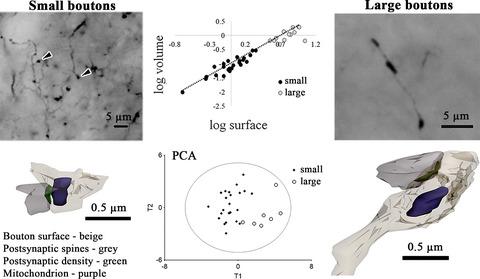当前位置:
X-MOL 学术
›
Eur. J. Nerosci.
›
论文详情
Our official English website, www.x-mol.net, welcomes your feedback! (Note: you will need to create a separate account there.)
Synaptic organization of cortico-cortical communication in primates.
European Journal of Neroscience ( IF 3.4 ) Pub Date : 2020-07-12 , DOI: 10.1111/ejn.14905 Maria Ashaber 1 , László Zalányi 2 , Emese Pálfi 2, 3 , István Stuber 4 , Tamás Kovács 5 , Anna W Roe 6, 7, 8 , Rob M Friedman 6 , László Négyessy 2
European Journal of Neroscience ( IF 3.4 ) Pub Date : 2020-07-12 , DOI: 10.1111/ejn.14905 Maria Ashaber 1 , László Zalányi 2 , Emese Pálfi 2, 3 , István Stuber 4 , Tamás Kovács 5 , Anna W Roe 6, 7, 8 , Rob M Friedman 6 , László Négyessy 2
Affiliation

|
In cortical circuitry, synaptic communication across areas is based on two types of axon terminals, small and large, with modulatory and driving roles, respectively. In contrast, it is not known whether similar synaptic specializations exist for intra‐areal projections. Using anterograde tracing and three‐dimensional reconstruction by electron microscopy (3D‐EM), we asked whether large boutons form synapses in the circuit of somatosensory cortical areas 3b and 1. In contrast to observations in macaque visual cortex, light microscopy showed both small and large boutons not only in inter‐areal pathways, but also in long‐distance intrinsic connections. 3D‐EM showed that correlation of surface and volume provides a powerful tool for classifying cortical endings. Principal component analysis supported this observation and highlighted the significance of the size of mitochondria as a distinguishing feature of bouton type. The larger mitochondrion and higher degree of perforated postsynaptic density associated with large rather than to small boutons support the driver‐like function of large boutons. In contrast to bouton size and complexity, the size of the postsynaptic density appeared invariant across the bouton types. Comparative studies in human supported that size is a major distinguishing factor of bouton type in the cerebral cortex. In conclusion, the driver‐like function of the large endings could facilitate fast dissemination of tactile information within the intrinsic and inter‐areal circuitry of areas 3b and 1.
中文翻译:

灵长类动物皮质-皮质交流的突触组织。
在皮层电路中,跨区域的突触通信基于两种类型的轴突终端,小的和大的,分别具有调节和驱动作用。相比之下,不知道区域内投影是否存在类似的突触特化。使用顺行追踪和电子显微镜 (3D-EM) 三维重建,我们询问是否在体感皮层区域 3b 和 1 的回路中形成大的突触。不仅在区域间路径中,而且在长距离内在连接中也有大的boutons。3D-EM 显示表面和体积的相关性为皮质末端分类提供了强大的工具。主成分分析支持这一观察,并强调了线粒体大小作为 bouton 类型的一个显着特征的重要性。较大的线粒体和更高程度的穿孔突触后密度与大而不是小 boutons 相关,支持大 boutons 的类似驱动程序的功能。与 bouton 的大小和复杂性相反,突触后密度的大小在 bouton 类型中似乎是不变的。人类的比较研究支持大小是大脑皮层中布顿类型的主要区别因素。总之,大末端的类似驱动器的功能可以促进触觉信息在区域 3b 和 1 的内在和区域间电路内的快速传播。较大的线粒体和更高程度的穿孔突触后密度与大而不是小 boutons 相关,支持大 boutons 的类似驱动程序的功能。与 bouton 的大小和复杂性相反,突触后密度的大小在 bouton 类型中似乎是不变的。人类的比较研究支持大小是大脑皮层中布顿类型的主要区别因素。总之,大末端的类似驱动程序的功能可以促进触觉信息在区域 3b 和 1 的内在和区域间电路内的快速传播。较大的线粒体和更高程度的穿孔突触后密度与大而不是小 boutons 相关,支持大 boutons 的类似驱动程序的功能。与 bouton 的大小和复杂性相反,突触后密度的大小在 bouton 类型中似乎是不变的。人类的比较研究支持大小是大脑皮层中布顿类型的主要区别因素。总之,大末端的类似驱动程序的功能可以促进触觉信息在区域 3b 和 1 的内在和区域间电路内的快速传播。突触后密度的大小在整个 boton 类型中似乎是不变的。人类的比较研究支持大小是大脑皮层中布顿类型的主要区别因素。总之,大末端的类似驱动程序的功能可以促进触觉信息在区域 3b 和 1 的内在和区域间电路内的快速传播。突触后密度的大小在整个 boton 类型中似乎是不变的。人类的比较研究支持大小是大脑皮层中布顿类型的主要区别因素。总之,大末端的类似驱动程序的功能可以促进触觉信息在区域 3b 和 1 的内在和区域间电路内的快速传播。
更新日期:2020-07-12
中文翻译:

灵长类动物皮质-皮质交流的突触组织。
在皮层电路中,跨区域的突触通信基于两种类型的轴突终端,小的和大的,分别具有调节和驱动作用。相比之下,不知道区域内投影是否存在类似的突触特化。使用顺行追踪和电子显微镜 (3D-EM) 三维重建,我们询问是否在体感皮层区域 3b 和 1 的回路中形成大的突触。不仅在区域间路径中,而且在长距离内在连接中也有大的boutons。3D-EM 显示表面和体积的相关性为皮质末端分类提供了强大的工具。主成分分析支持这一观察,并强调了线粒体大小作为 bouton 类型的一个显着特征的重要性。较大的线粒体和更高程度的穿孔突触后密度与大而不是小 boutons 相关,支持大 boutons 的类似驱动程序的功能。与 bouton 的大小和复杂性相反,突触后密度的大小在 bouton 类型中似乎是不变的。人类的比较研究支持大小是大脑皮层中布顿类型的主要区别因素。总之,大末端的类似驱动器的功能可以促进触觉信息在区域 3b 和 1 的内在和区域间电路内的快速传播。较大的线粒体和更高程度的穿孔突触后密度与大而不是小 boutons 相关,支持大 boutons 的类似驱动程序的功能。与 bouton 的大小和复杂性相反,突触后密度的大小在 bouton 类型中似乎是不变的。人类的比较研究支持大小是大脑皮层中布顿类型的主要区别因素。总之,大末端的类似驱动程序的功能可以促进触觉信息在区域 3b 和 1 的内在和区域间电路内的快速传播。较大的线粒体和更高程度的穿孔突触后密度与大而不是小 boutons 相关,支持大 boutons 的类似驱动程序的功能。与 bouton 的大小和复杂性相反,突触后密度的大小在 bouton 类型中似乎是不变的。人类的比较研究支持大小是大脑皮层中布顿类型的主要区别因素。总之,大末端的类似驱动程序的功能可以促进触觉信息在区域 3b 和 1 的内在和区域间电路内的快速传播。突触后密度的大小在整个 boton 类型中似乎是不变的。人类的比较研究支持大小是大脑皮层中布顿类型的主要区别因素。总之,大末端的类似驱动程序的功能可以促进触觉信息在区域 3b 和 1 的内在和区域间电路内的快速传播。突触后密度的大小在整个 boton 类型中似乎是不变的。人类的比较研究支持大小是大脑皮层中布顿类型的主要区别因素。总之,大末端的类似驱动程序的功能可以促进触觉信息在区域 3b 和 1 的内在和区域间电路内的快速传播。


























 京公网安备 11010802027423号
京公网安备 11010802027423号